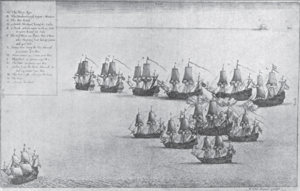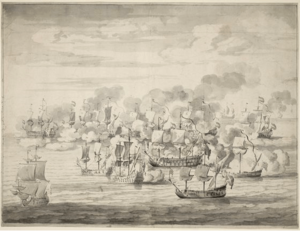Battle of Cádiz (1669) facts for kids
Quick facts for kids Battle of Cádiz |
|||||||
|---|---|---|---|---|---|---|---|
 Engraving of the battle by Wenceslaus Hollar, an eyewitness |
|||||||
|
|||||||
| Belligerents | |||||||
| Commanders and leaders | |||||||
| Strength | |||||||
| 1 frigate 1 ketch 1 pink |
6 frigates 1 sloop |
||||||
| Casualties and losses | |||||||
| 12 killed 18 wounded |
Heavy | ||||||
The Battle of Cádiz happened on December 18-19, 1669, near Cádiz in the Atlantic Ocean. It was a fight between an English warship called the Mary Rose, led by Rear-Admiral John Kempthorne, and a group of seven pirate ships from Algiers. The Mary Rose was protecting several merchant ships. An artist named Wenceslaus Hollar was there and later drew the battle.
The Mary Rose was coming back from a special trip to Morocco. On this trip, the ship had rescued an English merchant ship called the King David from Barbary pirates. The Mary Rose was towing the King David and sailing with five other ships when they met the pirate fleet. Six pirate ships attacked the Mary Rose, while one chased the King David, which Kempthorne had to let go. The pirates stopped fighting when night came but attacked again the next morning. Even though the Mary Rose was damaged, she fought off the pirates. The pirates only managed to capture the King David. After getting repairs in Cádiz, the Mary Rose returned to England. Admiral Kempthorne was later made a knight for his bravery.
Contents
Why the Battle Happened
The Mary Rose was a strong English warship with 48 guns. In 1668 or 1669, she took Lord Henry Howard to Tangier in Morocco. Lord Howard was on a mission from King Charles II to make a trade agreement with the Moroccan ruler, Al-Rashid. The artist Wenceslaus Hollar also joined this trip. He wanted to finish drawings of Tangier that he had started earlier.
The meeting with the Moroccan ruler was delayed and never happened. So, Lord Howard and his group decided to travel by land, and the Mary Rose would sail to Salé. The Mary Rose was sailing with three other ships: a small ship called the Roe ketch, and a merchant ship from Hamburg.
Meeting the King David
One night, they caught up to a large ship called the King David. This ship was an English trader sailing from New England to Cádiz. But it had been captured by pirates from Algiers, and its captain and crew were taken prisoner. When the Mary Rose found the King David, it had 22 Algerine pirates, one Russian, and two Englishmen on board. The English sailors took control of the King David again.
The King David was slow and full of cargo, so the Mary Rose had to tow it. This made the convoy slow. They arrived at Salé on December 11th. There, they learned that there was trouble on land, so they couldn't go ashore. A storm then forced them to leave the coast. On December 17th, two more merchant ships joined the convoy for protection because they had seen Algerine pirate ships.
The Battle Begins
At sunrise on December 18th, the Mary Rose spotted seven Algerine pirate warships. The Mary Rose quickly got ready for a fight. They cleared the decks to use their guns and let the King David drift away. The pirate ships passed by around noon. One of the prisoners on the Mary Rose identified the pirate ships by name: the Golden Lion, Orange Tree, Half Moon, Seven Stars, White Horse, Blewhart, and Rose Leaf.
Six of the pirate ships attacked the Mary Rose around 3:00 PM. The Rose Leaf chased the abandoned King David. Hollar described it as "a hot Service, and much harm done on both sides." The fighting continued until nightfall, when the pirate ships pulled back.
Day Two of Fighting
Early the next morning, the two groups started fighting again. The Algerine ships approached in a line, firing their cannons and small guns at the Mary Rose. The Mary Rose fired back, trying to hit all the approaching ships. The Golden Lion, which was the pirate leader's ship, tried to get close enough to board the Mary Rose. However, the Mary Rose hit the Golden Lion's hull below the water and damaged its main sail. Because of this damage, the Golden Lion and the other pirate ships retreated.
During the battle, the French and Scottish merchant ships managed to escape. Some people on the small pink ship tried to give their ship to the Algerines, but the pirates thought it was a fire ship sent by the English to destroy them. So, the attempt failed when the pirates retreated. The English lost 12 men and had 18 wounded. The Mary Rose had damage to all three of its masts.
What Happened Next
The Mary Rose arrived in Cádiz on December 20th. Kempthorne sold the 22 Algerine prisoners. The Mary Rose returned to England in April 1670. Admiral Kempthorne was knighted for his "very great valour" against the pirates.
The King David, which had been captured by the Rose Leaf, was later rescued by Sir Thomas Allin. The original owners of the King David successfully asked to have their ship returned to them. In July 1670, King Charles II ordered that money from selling captured Moorish prisoners should be used to free Englishmen who had been taken prisoner. This included the crew of the King David.
The Battle in Art and Music
Wenceslaus Hollar, who was sketching on deck during the battle, later made an etching (a type of print) of the fight. This etching was included in a book called Africa in 1670. The picture shows the pirate ships attacking the Mary Rose, while the Rose Leaf chases the King David. The French merchant ship escapes, and other merchant ships hide behind the Mary Rose.
Another famous artist, Willem van de Velde the Younger, later made his own drawing and an oil painting of the battle, based on Hollar's work. This painting is now in the Royal Collection at Hampton Court Palace. There are other copies of this painting in different collections.
This battle also became part of a popular naval song, sometimes called "Turkish Men of War" or "The Royal Oak." The song often mixes up the names and numbers of the ships involved.
See also


